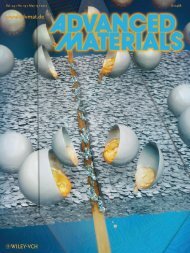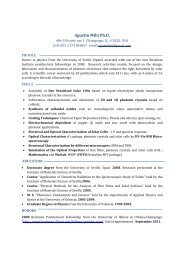Polymer Brushes for Molecular Transport - Paul Braun Research ...
Polymer Brushes for Molecular Transport - Paul Braun Research ...
Polymer Brushes for Molecular Transport - Paul Braun Research ...
You also want an ePaper? Increase the reach of your titles
YUMPU automatically turns print PDFs into web optimized ePapers that Google loves.
straight<strong>for</strong>ward, the actual implementation can be very expensive and time consuming, due to the<br />
high demands on resolution, placement accuracy, throughput, and defect density.[24]<br />
1.3.2 Microcontact printing on silica<br />
With the microcontact printing technique developed in the Whitesides group,[25, 26]<br />
microscale patterning of end-grafted polymer brushes on gold and silica surfaces has been<br />
achieved.[9, 27-34] In general, microcontact printing is a cost-efficient method to create two-<br />
dimensional patterns of organic materials on both hard and flexible surfaces with spatial<br />
resolutions approaching 250 nm (and better in specific cases).[35] Recently there have been<br />
multiple publications reporting the synthesis and properties of patterned polymer brushes on gold<br />
substrates,[9, 29-32] but very few publications on patterned polymer brushes on silica<br />
surfaces.[27, 33, 34] This may be because the reproducible <strong>for</strong>mation of organosilane<br />
monolayers on silica can be difficult, and the film quality is sensitive to the details of the reaction<br />
conditions including temperature, solvent, water content of the solvent, and deposition time.[36-<br />
38] But recent publications have demonstrated that by controlling the reaction conditions<br />
carefully, highly ordered alkyltrichlorosilane based SAMs can be reproducibly patterned.[27, 37,<br />
39] Inherently, patterned polymer brushes on silica have many advantages over similar brushes<br />
on gold. The silane/silica interface is much stronger than the thiol/gold interface. The S-Au<br />
bond energy is 30-40 kcal/mol[30] while the Si-O bond dissociation energy is 96-133 kcal mol -1<br />
and the Si-C bond dissociation energy is 90-95 kcal/mol.[40] The stability of polymer brushes<br />
<strong>for</strong>med on silica surfaces can be further increased with the crosslinked polysiloxane structure<br />
<strong>for</strong>med on the substrate surface when multifunctional silanes are used as end grafting agents.[37]<br />
Silica substrates are low in cost, stable (high tolerance to UV, heat, sonication and oxidation),<br />
smooth, and easy to prepare, whereas gold films are prone to delamination (at least in our<br />
10




